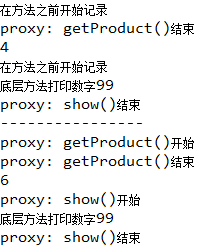2 Möglichkeiten zur Implementierung eines dynamischen Java-Proxys
- 高洛峰Original
- 2016-11-30 14:59:302482Durchsuche
Der dynamische Proxy von Java wird in der API erklärt, die eine Verbindung zu Java herstellt, daher werde ich ihn hier nicht schreiben. Den Proxy verstehe ich:
Eine Erweiterung der Funktionalität einer bestimmten Methode in einer bestimmten Schnittstelle ist ein Proxy. Ein Proxy ruft Methoden über das der Proxy-Instanz zugeordnete Aufruf-Handler-Objekt auf.
Schauen wir uns ein Beispiel an:
Schnittstelle:
public interface Num {
void show();
int getNum();
int getProduct(int x);
}Implementierungsklasse:
public class MyNum implements Num {
@Override
public int getNum() {
return 3;
}
@Override
public int getProduct(int x) {
return x;
}
@Override
public void show() {
System.out.println("底层方法打印数字99");
}
}Schauen wir uns zunächst die Aufrufmethode an in Methode Wie wird es in der API beschrieben?

bedeutet, dass der Aufrufhandler die zugrunde liegende Methode aufruft, die durch das Methodenobjekt im Implementierungsklassenobjekt der Schnittstelle dargestellt wird.
Die erste Möglichkeit, einen Proxy zu implementieren:
public class NumProxy {
private Object num;
//通过构造方法构造接口的实现类对象
public NumProxy(Object num) {
this.num = num;
}
public Object getNumByProxy(){
Object numProxy = Proxy.newProxyInstance(num.getClass().getClassLoader(), new Class[]{Num.class}, new InvocationHandler() {
/**
* method: 对应于在代理实例上调用的接口方法的 Method 实例。我理解的就是被代理的真实方法实例
* args: 我理解的是真实方法的参数数组
*/
@Override
public Object invoke(Object proxy, Method method, Object[] args)
throws Throwable {
Object obj = null;
System.out.println("在方法之前开始记录");
String methodName = method.getName();
if("getProduct".equals(methodName)){
obj = method.invoke(num, args);
obj = (Integer) obj * 2;
System.out.println("proxy: getProduct()结束");
}
else if("show".equals(methodName)){
obj = method.invoke(num, args);
System.out.println("proxy: show()结束");
}
return obj;
}
});
return numProxy;
}
}Die zweite Möglichkeit, einen Proxy zu implementieren: durch Implementierung der InvocationHandler-Schnittstelle
public class NumProxyImpl implements InvocationHandler {
//这里我把接口类型具体化了, 没有写成Object
private Num num;
public NumProxyImpl(Num num){
this.num = num;
}
@Override
public Object invoke(Object proxy, Method method, Object[] args)
throws Throwable {
Object obj = null;
String methodName = method.getName();
if("getProduct".equals(methodName)){
System.out.println("proxy: getProduct()开始");
obj = method.invoke(num, args);
obj = (Integer) obj * 2;
System.out.println("proxy: getProduct()结束");
}else if("show".equals(methodName)){
System.out.println("proxy: show()开始");
obj = method.invoke(num, args);
System.out.println("proxy: show()结束");
}
return obj;
}
}Testcode:
public class TestNum {
public static void main(String[] args) {
//两种方式一起测试
NumProxy np = new NumProxy(new MyNum());
Num numProxy = (Num) np.getNumByProxy();
int x = numProxy.getProduct(2);
System.out.println(x);
numProxy.show();
System.out.println("----------------");
NumProxyImpl npi = new NumProxyImpl(new MyNum());
Num numPro = (Num) Proxy.newProxyInstance(Num.class.getClassLoader(), new Class[]{Num.class}, npi);
int n = numPro.getProduct(3);
System.out.println(n);
numPro.show();
}
}Konsolenergebnisse:

Die zweite Methode ist etwas verwirrend, ich weiß nicht, ob Sie sie haben, nämlich den Aufruf in NumProxyImpl wird nicht explizit aufgerufen, aber sie wurde implementiert, äh, äh, schauen Sie sich das selbst an
Wenn Sie sich nicht die Mühe machen möchten, merken Sie es sich einfach.
Zum Beispiel kann ein Proxy für die Codierungsverarbeitung verwendet werden. Ich werde das nächste Mal ein Beispiel schreiben.

